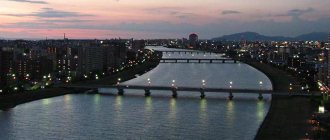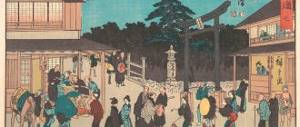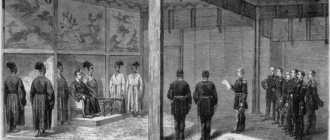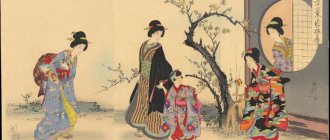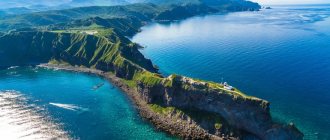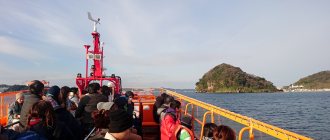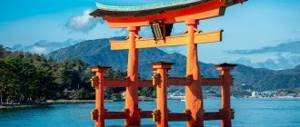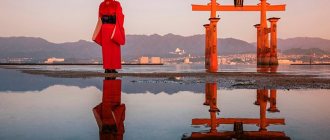Edo period (1603 – 1867)
Tokugawa Ieyasu, an associate of Toyotomi Hideyoshi and Oda Nobunaga, took control as the most powerful man in Japan.
When Hideyoshi was dying, he asked Ieyasu to forever care for his heir son Hideyori and the Toyotomi family. Of course, Tokugawa broke his promise and did not support Hideyoshi’s heir, since he wanted to rule Japan himself. At the Battle of Sekigahara in 1600, Ieyasu defeated Hideyori's supporters and his other opponents from the west. Thus, he received unlimited power over the country. In 1603, under the authority of Emperor Ieyasu, he was proclaimed shogun. He founded his government in Edo (now Tokyo). The Tokugawa Shogunate ruled Japan for 250 years.
Ieyasu strictly controlled the entire country. He skillfully distributed the land among the daimyo: the most loyal vassals (those who supported him even before the Battle of Sekigahara) received strategically more important areas.
For complete control over society, a system of 5 classes was created during the Edo period: samurai stood at the top of the social pyramid, followed by peasants, artisans and merchants. The “eta” pariahs, who were engaged in work that was “dirty” according to Buddhist canons, formed the most discriminated class, the fifth class. Citizens of the country were prohibited from changing their social status.
Shogun Ieyasu continued to develop international trade relations. He established trade relations with England and Germany. At the same time, in 1614, he achieved a complete ban on Christianity in order to prevent dangerous influence from outside.
After the destruction of the Toyotomi clan in 1615 and the capture of Osaka, Ieyasu and his heirs had practically no opponents, and the Edo period can be called a time of peace. Warriors (samurai) studied not only martial arts, but also literature, philosophy, and art. Zen Buddhism and Neo-Confucianism spread among them the principles of self-discipline, morality and devotion.
In 1633, Shogun Iemitsu banned long-distance voyages and almost completely isolated Japan in 1639, limiting connections with the outside world to trade with China and Holland through the port of Nagasaki. All foreign books were banned.
Thanks to isolation, the quality of local agricultural products improved, the domestic market developed, and culture flourished. Among the urban population, such art forms as kabuki theater and ukiyo-e - pictures on everyday themes - were gaining popularity.
The Tokugawa government remained stable for centuries, but over time its position became increasingly precarious. The merchant class developed so quickly that soon many samurai became financially dependent on it. As a result, class differences between merchants and samurai were smoothed out, and the power of the latter gradually declined. In addition, high taxes and famine caused an increase in the number of peasant uprisings.
In 1720, the ban on foreign literature was lifted, and new philosophical teachings from China and Europe (Germany) spread to Japan.
At the end of the 18th century, pressure from the rest of the world began to increase. At first, Russia tried unsuccessfully to establish trade relations with Japan. Its example was followed in the 19th century by European states and the United States.
An American officer, Commodore Perry, succeeded in forcing the Japanese government to open several ports to maritime trade in 1853 and 1854, but foreign trade relations remained insignificant until the Meiji Restoration in 1868.
Perry's actions gave rise to a wave of anti-Western sentiment and criticism of the Tokugawa shogunate, as well as a growing movement in support of the restoration of imperial power.
The anti-Western and pro-imperial movement “Sonno Joi” (“Long live the emperor! Death to the barbarians!”) spread widely among the samurai of the provinces of Choshu and Satsuma. More restrained politicians, however, understood the significance of the achievements of science and military art of the West and preferred to open Japan to the outside world. Soon the Conservatives, having taken part in several battles with European and American fleets, also realized the benefits of new technologies.
Japan at the beginning of our era
Around the first millennium BC, settlers from China and Korea appeared on the territory of the Japanese archipelago. Migrants brought innovations to Japan such as widespread metalworking (bronze, copper, and iron), weaving, pottery, and the spread of agriculture. It was from this time that the population began to sow rice, beans, and millet. In the history of Japan, this period is usually called the Yayoi period (900 BC - 300 AD).
In addition to the development of the economy and crafts, it should be noted the unification of various tribes and clans into larger groups. However, this process cannot be called peaceful - the merger occurred as a result of inter-tribal and inter-clan wars and skirmishes. In other words, stronger and more numerous tribes displaced weaker and smaller ones.
The Yayoi period was replaced by the Kofun period, which was characterized by the unification of territories under the rule of the Yamato clan. The territory of his lands included Central and Western Honshu and the lands of Kyushu.
Since 538 AD e the Asuka period reigned on the territory of modern Japan. The migration of tribes from China contributed to the penetration of Buddhism into the territory of the Land of the Rising Sun. During the Asuka period, this religion managed to spread widely among the local population. Moreover, it was during these years that Japanese culture flourished rapidly and a code of laws was developed (it was called “ritsure”).
As we already mentioned at the very beginning, the history of Japan goes back centuries, it is rich and interesting, but it is impossible to talk about all the milestones in the development and formation of this state in one article. By the way, there is no reliable information about the date of the appearance of the first centralized state in the Land of the Rising Sun before the 7th century. This is explained by the lack of writing, so in these matters one can only rely on other historical chronicles, for example Chinese.
Meiji period (1867 – 1912)
In 1867-1868, the Tokugawa government, under military pressure, withdrew from the scene, and the power of Emperor Meiji was restored.
After the Restoration, the emperor left Kyoto and moved to the new capital, Tokyo. Political power shifted from the hands of the Tokugawa shogunate to a small group of nobles and former samurai.
The new Japan decisively began to catch up with the West in economic and military relations. Large-scale reforms took place throughout the country. The new government dreamed of making Japan a democratic country of universal equality. The boundaries between social classes created by the Tokugawa shogunate were blurred. The samurai were the most dissatisfied with this reform, because they lost all their privileges. Guarantees of human rights were also proclaimed, for example, freedom of religion was declared in 1873.
In order to stabilize the new government, all former feudal daimyos had to return their lands to the emperor, receiving in return substantial monetary compensation. This process was completed by 1870. The country was then divided into prefectures.
The Japanese education system was reformed first according to the French and then according to the German model. Compulsory primary education was introduced . After about 20-30 years of intense “Westernization,” the government listened to conservatives and nationalists: educational programs emphasized the study and veneration of Confucianism and Shintoism (including the cult of the emperor ).
It was extremely important for Japan to be on par militarily with the imperialist states. After all, like other Asian countries, Japan was forced to sign unfavorable agreements by force. Universal conscription was introduced, the land army was reorganized along the lines of the Prussian forces, and the navy along those of the British Navy.
In order to accelerate the transformation of Japan from an agricultural country to an industrial one, some students went to the West to study sciences and languages, and foreign teachers were invited to teach the rest. Huge amounts of money were invested in the development of transport and communications. The government supported the development of business and industry, especially the zaibatsu monopolies, Japanese oligarchies.
Enormous fiscal spending led to the financial crisis of the mid-1880s, followed by monetary reform and the establishment of the Bank of Japan.
Before World War II, the fastest growing industry was the textile industry. Working conditions in the factories were poor, and the emerging liberal and socialist movements were ruthlessly suppressed by the ruling Genro group, which consisted of the emperor's closest associates - the new Japanese "oligarchs".
Japan received its first Constitution in 1889. A parliament appeared, but the emperor retained his independence: he stood at the head of the army, navy, executive and legislative powers. However, the main political power remained in the hands of the Genro members - Emperor Meiji agreed with most of their actions. Political parties have not yet had sufficient influence, primarily due to constant internal strife.
The conflict between China and Japan over the division of spheres of influence in Korea led to the Sino-Japanese War of 1894-1895. The Japanese were victorious and captured Taiwan, but Western powers forced them to return the remaining conquered territories to China. This forced the Japanese army and navy to accelerate rearmament.
A new conflict of interests in China and Manchuria, this time with Russia, led to the Russo-Japanese War of 1904-1905. Japan won this war as well, increasing its territory and gaining international respect. Japan later increased its influence in Korea and annexed it in 1910. These military successes led to an unprecedented rise in nationalism.
In 1912, Emperor Meiji died. The era of Genro's reign is over.
At the origins of history
Today, the “Twenty-Four Stories” is considered to be the very first written source in which Ancient Japan is mentioned. These are Chinese historical chronicles that date back to the 1st century. However, the history of Japan began much earlier, approximately 35-40 thousand years BC. Scientists came to this conclusion after studying archaeological excavations carried out on the territory of modern Japan.
According to historians, people inhabited the Japanese archipelago during the Late Paleolithic. This period lasted until the 12th millennium BC. As history shows, in ancient Japan people were hunters and gatherers. Among the tools of labor, there were only stone tools, distinguished by rough processing. Quite often this period is referred to as the pre-ceramic period.
12th millennium BC e. was marked by the advent of a period called Jomon, which can be compared with the Neolithic and Mesolithic. At this time, the Japanese archipelago was completing its formation, the first settlements appeared on the coast, and the people inhabiting these territories began to use ceramics.
As for the ethnic origin of the Japanese, its formation, according to the history of Ancient Japan, was greatly influenced by the Ainu and people from the eastern coast of the Asian continent. In addition, Austronesian tribes lived on the islands of Shikoku and Kyushu.
Militarism and World War II
During the reign of the weak Emperor Taisho (1912 - 1926), political power gradually shifted from the Genro oligarchs to the parliament and democratic parties. In World War I, Japan joined the Entente, but played a very minor role in the battles with German troops in East Asia.
After the war, the economic situation in Japan worsened. The Great Kanto Earthquake of 1923 and the World Economic Crisis of 1929 brought the country to the brink of disaster.
One of the ways to solve Japan's problems was territorial expansion: after the war, Western countries had colonies around the world.
During the 1930s, the military established almost complete control over the government while maintaining independence from it. Their political enemies were killed and communism was persecuted. Indoctrination and censorship in education and the media have been tightened. Later, army and navy officers occupied many important government offices and even the post of prime minister.
The main target of Japan's expansion was China. Previously, the Japanese government forced China to take actions that were economically and politically unfavorable for it. In addition, many Japanese had previously emigrated to China, especially to Manchuria.
In 1931, the Japanese army occupied Manchuria . The following year, the puppet state of Manchukuo was declared a protectorate of Japan. That same year, the Japanese Air Force began bombing Shanghai, ostensibly to protect Japanese living in China from the anti-Japanese movement.
In 1933, Japan withdrew from the League of Nations because it was heavily criticized for its actions in China.
In July 1937, the Second Sino-Japanese War began . The small incident escalated into a full-scale military operation, with the army operating independently of the more moderate Japanese government.
Japanese troops completely occupied the coast of China and committed atrocities against the local population, especially after the capture of Nanjing. However, the Chinese government did not give up, and the war continued until 1945.
Japan's next step was to conquer Southeast Asia and establish the "Great Belt of Asian Prosperity" and liberate Northeast Asia from Europeans. In 1940, Japan occupied French Indochina (Vietnam) and joined the Axis (alliance of Germany and Italy). These actions accelerated the flare-up of the conflict between Japan, the United States and Great Britain, which staged an oil boycott of Japan. Therefore, the Japanese government decided to seize the Dutch East Indies (Indonesia), a region rich in oil, at the risk of starting a war with the United States and Great Britain.
In December 1941, Japan attacked the United States at Pearl Harbor and within six months extended its control over a vast territory - to the borders of India in the west and New Guinea in the south.
The turning point of the Pacific War was the Battle of Midway in June 1942. By intercepting and deciphering the radio messages of the Japanese army, the US military forces were able to defeat and inflict enormous damage on the enemy. After this battle, the Allies gradually recaptured all the territories captured by Japan.
In 1944, heavy bombing of Japan began , and in desperation the Japanese began using suicide pilots (kamikazes) against the Allies. The war ended in Okinawa in 1945.
On July 27, 1945, the Allies invited Japan to sign the Potsdam Declaration of Surrender, threatening to continue the destruction of the country . But the military did not think of giving up, even after the United States dropped two atomic bombs on Hiroshima and Nagasaki on August 6 and 9, and after the Soviet Union declared war on Japan on August 8.
However, on August 14, the more sober Emperor Hirohito decided on unconditional surrender.
Development of the country during the Nara and Heian eras (710-1185)
In 710, the first official capital appeared in Japan - the city of Nara. During the construction of the city, the main reference point was Chinese settlements. In particular, many monasteries were erected here, and the buildings were completely identical in appearance to Chinese houses. This feature largely influenced the future fate of the city. So, in order to avoid increasing the political weight of Buddhist temples, in 1184 they decided to move the capital to the city of Nagaoka, and even later to Heian (it had the status of the main city of Japan for almost 1000 years).
The Nara era in Japanese history was marked by the fact that Chinese influence on Japanese culture weakened somewhat. If before this the main language was Chinese, now the Japanese have created their own alphabet - “kana”.
As for political power, it was concentrated in the hands of the Fujiwara clan for a long time.
The “Taika reforms”, adopted somewhat earlier, have already had an impact on the life and way of life of the people of Japan. The main essence of these reforms was to increase taxes on peasants. Along with this, the aristocracy and monasteries, on the contrary, were exempt from paying taxes. The result is the strengthening of the influence of large landowners and the people remaining below the poverty line.
At the beginning of the 12th century, Fujiwara's power was limited. At the same time, a struggle for power unfolded between two clans: Minamoto and Taira. As a result of the uprising in 1159, the Taira clan was able to retain the reins of power in its hands, whose dominance continued until 1178. The death of Taira Kiyomore again plunged the country into a power struggle, which resulted in the Genpei War (1180-1185).
Kamakura era (1185-1333)
The Battle of Dannoura (in 1185) brought victory to the Minamoto clan, which defeated the Taira clan by a large margin. Already in 1192, the Minamoto were able to assign themselves the title of shogun (which means commander-in-chief). Their main goal was to weaken the influence of the imperial house and establish their own power in the country. The history of Japan during this period is characterized by dual power.
They located their headquarters in the city of Kamakura (which is where the name of the Japanese shogunate came from). However, the decision to locate the capital of the shogunate in Kamakura was ill-advised. This city was located in an economically backward area of the country, which resulted in economic weakness and collapse.
At the same time, the Mongols launched an attack on the country, weakened by internal political struggle. in 1266, Kublai Khan demands recognition of his power, but Japan resists. The response to such a daring refusal was an attack by the Mongol fleet. In November 1274, the enemy approached the western shores of Japan, captured the islands of Iki and Tsushima and began landing on the northwestern coast of Kyushu.
The samurai troops fought selflessly, but they were clearly not ready for such active combat operations and such numerous enemy troops. The battle was interrupted by a powerful typhoon, which destroyed about 200 ships of the Mongol army.
The Mongols launched a new campaign against Japan in June-August 1281. The invaders approached the Japanese shores from two sides: the first armada moved from China, the second from the Korean Peninsula. In total, about 3,500 ships and boats took part in the campaign. By that time, the Japanese had already managed to strengthen the fortifications and prepare, but this time too the enemy fleet was sunk by a typhoon. It was from then on that typhoons began to be called “kamikaze”, which translated from Japanese means “Divine Wind”.
